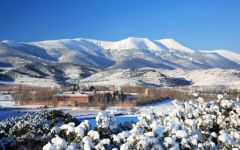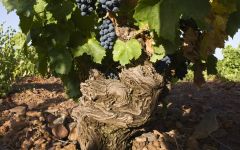Borsao Tres Picos Garnacha 2019
-
James
Suckling -
Wine
Spectator



Product Details
Your Rating
Somm Note
Winemaker Notes
Very intense cherry red color with tones of purple. Presents in the nose a great concentration of aromas of ripe red fruit with floral nuances. In the mouth, it is a well structured rich wine that evokes tastes of blackberry, plum and tones of leather and vanilla, with a soft and silky tannin.
Pair with barbecue, vegetables, beef and pork, rice and pasta based dishes. Also goes well with cheese and hearty meals, such as chili, shepard's pie, and lasagna.
Professional Ratings
-
James Suckling
Berry and cedar aromas follow through to a medium body with firm tannins and a savory finish. Just a hint of toffee at the end.
-
Wine Spectator
A rich red in a modern style, with an overtone of toasty smoke and a firm frame of tannins swathed in flavors of blackberry, blueberry and menthol. Fresh, spiced finish. Best After 2023.
Other Vintages
2020-
James
Suckling -
Wine
Spectator -
Wine
Enthusiast
-
James
Suckling
-
James
Suckling -
Wine
Spectator
-
Robert
Parker
-
Robert
Parker
-
Wine
Spectator -
Robert
Parker
-
Robert
Parker
-
Robert
Parker
-
Robert
Parker -
Wine
Spectator
-
Robert
Parker
-
Robert
Parker -
James
Suckling
-
Robert
Parker
-
Robert
Parker
-
Robert
Parker -
Wine
Spectator
-
Robert
Parker -
Wine
Spectator

Grenache thrives in any warm, Mediterranean climate where ample sunlight allows its clusters to achieve full phenolic ripeness. While Grenache's birthplace is Spain (there called Garnacha), today it is more recognized as the key player in the red blends of the Southern Rhône, namely Châteauneuf-du-Pape, Côtes du Rhône and its villages. Somm Secret—The Italian island of Sardinia produces bold, rustic, single varietal Grenache (there called Cannonau). California, Washington and Australia have achieved found success with Grenache, both flying solo and in blends.

Campo de Borja DO sits in the northwest province of Zaragoza (Aragon, Spain) south of Rioja and north of Cariñena. Since this area acquired DO status in the 1980s, it has gradually shown its own unique identity. Campo de Borja’s winegrowing history and heritage is rich in relation to Garnacha; the oldest vineyards in the DO date back to 1890. Furthermore, of the almost 4,000 hectares of this variety, more than 2,000 are between 30 and 50 years old.
Most production continues to be reds, and the number of crianzas and reservas is growing. Though less common, they produce white wines as well. Today, both red and rosé wines have won the respect of experts, and the intensely fruity, young red wines enjoy significant commercial success. The principal white grape varieties are Macabeo, Moscatel, Chardonnay, Garnacha Blanca, Sauvignon Blanc and Verdejo. The principal red grape varieties include Garnacha Tinta, Tempranillo, Syrah, Mazuela, Cabernet Sauvignon and Merlot.





